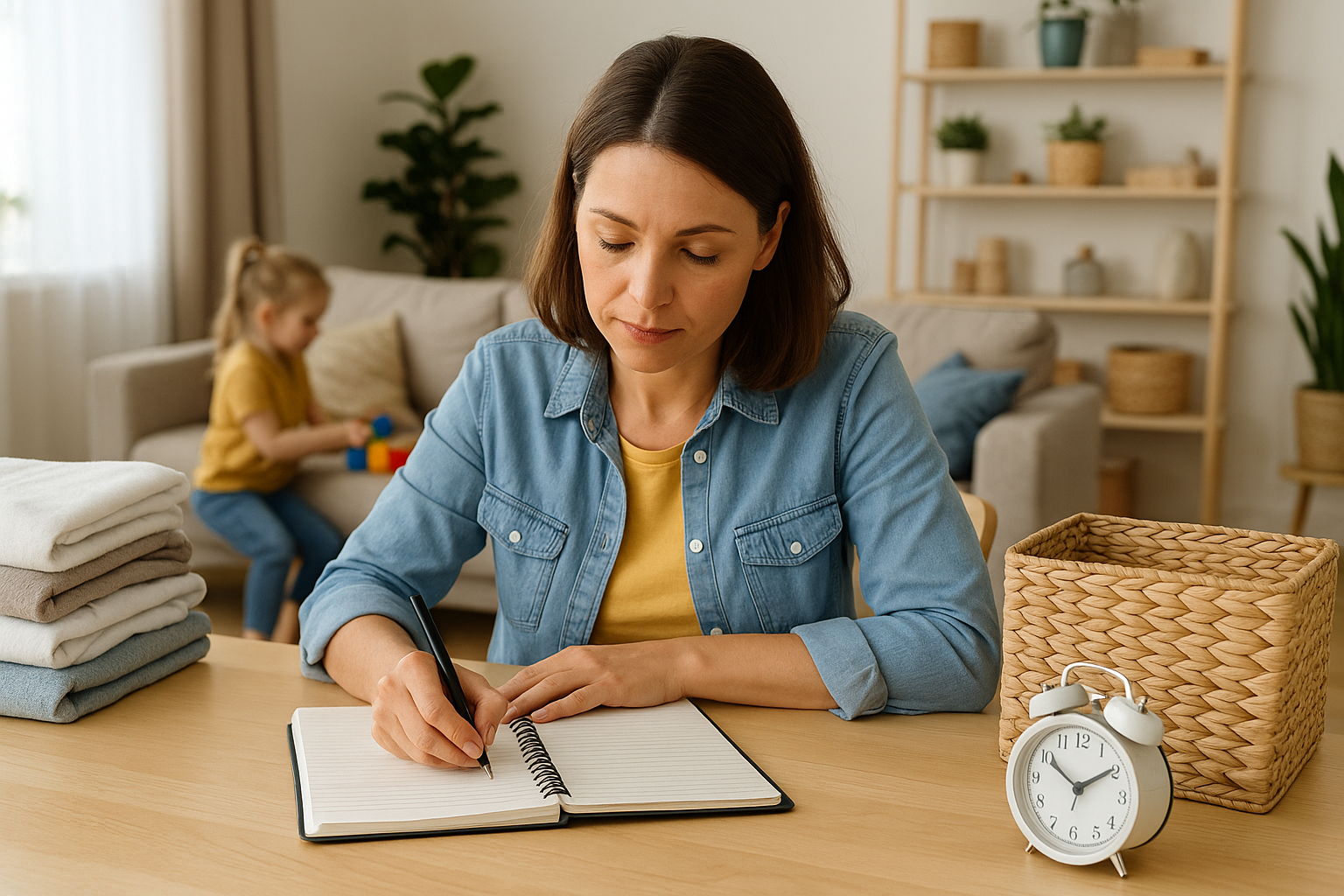Keeping your home organized may seem like a never-ending challenge, especially if you’re balancing work, children, errands, or just the general chaos of life.
However, the key to long-term organization is not perfection—it’s consistency. A solid daily routine not only helps maintain a tidy space but also reduces stress, boosts productivity, and gives you more time to relax.
Creating a daily routine doesn’t mean filling every minute with chores. It’s about building small, effective habits that support a clean and orderly home.
In this guide, you’ll learn how to design a sustainable and practical routine that fits your life and helps you stay on top of your home without feeling overwhelmed.
Understand Your Daily Patterns
Before you begin crafting a routine, observe your current lifestyle. Identify your peak productivity hours, the times when your energy drops, and which tasks are consistently left undone.
Are you more focused in the morning or late at night? Do you have kids at home during the day? These details will help you create a routine that works with your life, not against it.
Make a list of your daily non-negotiables: work hours, school runs, cooking, and any recurring commitments. Once you’ve mapped these out, you can identify small windows of time for organization and cleaning tasks.
Break the Day into Manageable Blocks
Rather than trying to clean the whole house in one go, break your day into blocks: morning, afternoon, and evening. Assign one or two light tasks to each block. For example:
Morning Block
- Make the beds
- Wipe down bathroom counters
- Start a load of laundry
Afternoon Block
- Unload the dishwasher
- Tidy up shared spaces (living room, kitchen counter)
- Fold laundry and put it away
Evening Block
- Prep for the next day (clothes, bags, etc.)
- Quick 10-minute tidy-up
- Set the dishwasher before bed
By distributing small tasks throughout the day, you avoid burnout and maintain a sense of control.
Use Timers to Stay Focused
One of the best ways to stick to a routine is to set a timer. This technique helps you stay focused and prevents you from spending too much time on a single task.
Set a timer for 10 to 20 minutes and clean or organize until it rings. You’ll be amazed at how much you can accomplish in a short, focused session.
You can also use music playlists or podcasts to keep you motivated during cleaning time. Make it fun so it feels less like a chore.
Establish Anchor Habits
Anchor habits are small actions that trigger larger routines. For example, once you brew your morning coffee, that could be your signal to make the bed. After brushing your teeth, you might wipe down the bathroom sink. These small connections help automate your routine and reduce decision fatigue.
Linking cleaning habits to actions you already do daily increases the likelihood that you’ll stick to your new system.
Prioritize High-Traffic Areas
Not every area of your home needs daily attention. Focus your daily routine on the spaces that get the most use—typically the kitchen, living room, and bathroom.
Keeping these zones clean will make your whole home feel more organized, even if less-used areas are addressed weekly.
Daily tasks in high-traffic areas might include:
- Wiping kitchen counters
- Sweeping or vacuuming high-use floors
- Tidying entryways
Once these areas are under control, it’s easier to find time for other tasks like organizing closets or deep cleaning.
Keep Cleaning Supplies Accessible
If you have to search for your tools every time you clean, it becomes a barrier to consistency. Store cleaning supplies where they’re used. Keep disinfecting wipes under the bathroom sink, sponges and spray in the kitchen, and a vacuum that’s easy to grab for quick jobs.
Creating cleaning stations around your home saves time and makes it easier to act when you spot a mess.
Delegate and Share Responsibilities
You don’t have to do everything yourself. If you live with a partner, roommates, or kids, include them in the routine.
Give age-appropriate tasks to children, and communicate clearly about expectations. Even young kids can pick up toys, wipe surfaces, or put away their clothes.
Create a simple chore chart or shared calendar to keep everyone accountable. It reduces your workload and encourages teamwork.
Use Checklists to Stay on Track
A visual checklist can be a game-changer. Whether you prefer paper planners or apps, list out your daily routine so you don’t have to rely on memory.
Checking off tasks as you go gives you a sense of accomplishment and motivation to keep going.
Some people prefer a daily list, while others use weekly trackers to allow for flexibility. Experiment and find what works best for you.
Include Time for Resetting
One of the most underrated parts of any routine is the daily reset. It’s a short period—usually at the end of the day—where you take 10 to 15 minutes to tidy surfaces, put things back where they belong, and mentally wrap up the day. This helps you start fresh in the morning and keeps clutter from building up.
Even better, a reset helps you wind down, reduces anxiety, and makes your home feel peaceful.
Make It Flexible and Forgiving
Life happens. Some days you won’t get everything done—and that’s okay. The goal is consistency over time, not perfection.
Build a flexible routine that allows you to shift or skip tasks without guilt. If you miss a morning chore, you can always move it to the afternoon or combine it with another task.
Be kind to yourself and avoid the all-or-nothing mindset. A little progress each day adds up quickly.
Rotate Deep Cleaning Into Your Routine
Once your daily system is in place, add in deeper cleaning tasks on a rotating schedule. For example:
Monday – Clean the fridge
Tuesday – Vacuum under furniture
Wednesday – Organize a drawer
Thursday – Clean windows
Friday – Dust baseboards
These don’t have to take long—just 15-30 minutes a day adds up to a thoroughly clean home over time.
Simplify Your Belongings
Clutter is one of the biggest obstacles to staying organized. The fewer items you own, the easier it is to maintain order.
Take time once a month to declutter one area—like a closet, drawer, or shelf. Ask yourself if you’ve used the item in the last year, or if it truly brings value.
Fewer items mean less to clean, less to store, and more mental space.
Create Morning and Evening Rituals
Start and end your day with routines that include light cleaning. For example:
Morning Ritual:
- Open windows or blinds
- Make the bed
- Wipe down counters after breakfast
Evening Ritual:
- Load dishwasher
- Quick pick-up of clutter
- Prepare for the next day
These mini-routines make the day flow more smoothly and keep your home tidy with minimal effort.
Embrace the Power of Visual Zones
Use zones to make organization intuitive. Designate specific areas for items—keys go in a dish by the door, backpacks hang on a hook, mail in a basket, shoes in a bin. This limits decision fatigue and helps everyone in the household know where things belong.
Labeling bins or shelves is especially helpful for kids and guests.
Avoid Multitasking While Organizing
When cleaning or tidying, focus on one space at a time. Avoid jumping from room to room—it creates confusion and often results in a bigger mess. Instead, complete one area fully before moving on to the next.
A focused 20-minute session in one space is more productive than a scattered hour across five rooms.
Review and Adjust Monthly
Every month, evaluate your routine. What’s working? What feels like a burden? Life changes, and your routine should evolve with it. If a new school year or job shift changes your schedule, don’t be afraid to make adjustments.
A monthly review helps you stay realistic and maintain a routine that actually fits your current lifestyle.
Celebrate Small Wins
Organization is a long game, and progress happens one habit at a time. Celebrate your consistency, not just perfection. If you followed your routine for five days this week, that’s a win. If you cleaned out one drawer, that’s worth celebrating.
Positive reinforcement keeps you motivated and builds momentum.
Final Thoughts: Your Home, Your System
There is no one-size-fits-all approach to home organization. The most effective routine is the one that works with your life, energy levels, and goals. Start small, stay consistent, and give yourself grace. In time, your daily routine will become second nature—and your home will reflect the calm and order you’ve created.

Marcela Silva is passionate about home organization, creative budgeting, and practical everyday solutions. With a sharp eye for the small details that make a big difference, Marcela shares accessible and effective tips to help people keep their homes more functional, clean, and welcoming. Her content is designed for those who seek practicality without sacrificing comfort and well-being, offering realistic suggestions that are easy to apply in daily life.
